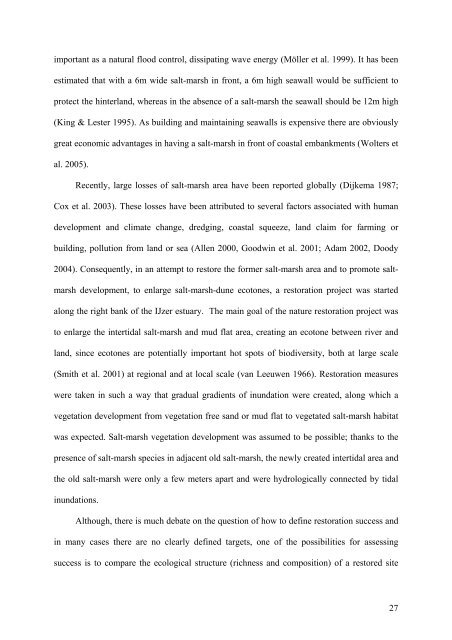PhD Reza Erfanzadeh 2009 - Ghent Ecology - Universiteit Gent
PhD Reza Erfanzadeh 2009 - Ghent Ecology - Universiteit Gent
PhD Reza Erfanzadeh 2009 - Ghent Ecology - Universiteit Gent
You also want an ePaper? Increase the reach of your titles
YUMPU automatically turns print PDFs into web optimized ePapers that Google loves.
important as a natural flood control, dissipating wave energy (Möller et al. 1999). It has been<br />
estimated that with a 6m wide salt-marsh in front, a 6m high seawall would be sufficient to<br />
protect the hinterland, whereas in the absence of a salt-marsh the seawall should be 12m high<br />
(King & Lester 1995). As building and maintaining seawalls is expensive there are obviously<br />
great economic advantages in having a salt-marsh in front of coastal embankments (Wolters et<br />
al. 2005).<br />
Recently, large losses of salt-marsh area have been reported globally (Dijkema 1987;<br />
Cox et al. 2003). These losses have been attributed to several factors associated with human<br />
development and climate change, dredging, coastal squeeze, land claim for farming or<br />
building, pollution from land or sea (Allen 2000, Goodwin et al. 2001; Adam 2002, Doody<br />
2004). Consequently, in an attempt to restore the former salt-marsh area and to promote salt-<br />
marsh development, to enlarge salt-marsh-dune ecotones, a restoration project was started<br />
along the right bank of the IJzer estuary. The main goal of the nature restoration project was<br />
to enlarge the intertidal salt-marsh and mud flat area, creating an ecotone between river and<br />
land, since ecotones are potentially important hot spots of biodiversity, both at large scale<br />
(Smith et al. 2001) at regional and at local scale (van Leeuwen 1966). Restoration measures<br />
were taken in such a way that gradual gradients of inundation were created, along which a<br />
vegetation development from vegetation free sand or mud flat to vegetated salt-marsh habitat<br />
was expected. Salt-marsh vegetation development was assumed to be possible; thanks to the<br />
presence of salt-marsh species in adjacent old salt-marsh, the newly created intertidal area and<br />
the old salt-marsh were only a few meters apart and were hydrologically connected by tidal<br />
inundations.<br />
Although, there is much debate on the question of how to define restoration success and<br />
in many cases there are no clearly defined targets, one of the possibilities for assessing<br />
success is to compare the ecological structure (richness and composition) of a restored site<br />
27










